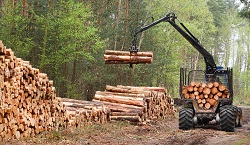European research infrastructure links forest science and bioeconomy
Forest-based industries are responsible for around 8 % of EU manufacturing and 3.5 million jobs, playing a major role in the European bioeconomy in the coming years. At the heart is the forest fibre and paper industry, creating value through use of sustainable raw materials to deliver innovative solutions that substitute fossil-based products. The EU-funded Horizon 2020 ERIFORE(opens in new window) project has facilitated the transformation to a circular forest bioeconomy by developing an open access distributed research and innovation infrastructure. “The initiative focused on spanning the gap between science and innovation to develop and commercialise novel biorefinery process concepts for producing value added chemicals and materials from forest-based raw materials,” says project coordinator Dr Mika Härkönen. The goal is to create a research and innovation infrastructure co-operation platform to optimise use of forest biomass sustainably and cost-effectively through new processes and concepts. A strategic approach The multidisciplinary European Strategy Forum on Research Infrastructures (ESFRI) successfully identified research infrastructures (RIs) that meet the long-term needs of the research community and other stakeholders. “A coherent, strategy for RI development generates clear advantages at the European level, such as avoiding duplication of efforts, pooling resources, rationalising RI use, standardising processes and procedures and consolidating the global leadership of European RIs,” explains Dr Härkönen. The RI creates a bridge between science and innovation, developing and commercialising novel biorefinery process concepts for producing value added materials and chemicals from lignocellulosic raw materials. According to Dr Härkönen: “Our vision is to act as a key contributor to the forest-based sector, enabling Europe to take the lead in the development and commercialisation of novel bio-based products.” The ESFRI study extensively mapped research needs and drivers, the availability and development needs of existing RIs, and collaboration in the field of circular forest bioeconomy. The study also outlined initial business models, financing plans and governance structures. All public deliverable reports are accessible on the ERIFORE website. Benefits from collaboration Scientific collaboration and long-term commitments from RI owners, national ministries and funding organisations can be ensured thanks to the legal framework created by the European Research Infrastructure Consortium (ERIC), which is recognised in all EU Member States. “The establishment of the ERIFORE-ERIC framework will guarantee that the voice of the forest-based bioeconomy is heard in policy-making bodies at both the national and EU level,” claims Dr Härkönen. Collaboration under the RI will bring notable benefits for ERIFORE partners as well as for the whole European research and innovation system in circular forest bioeconomy. Improved access, for example, will aid in developing and commercialising novel biorefinery process concepts for production of value added chemicals and materials from forest-based or other lignocellulosic raw materials. New business models aids sustainable growth In addition, ERIFORE-ERIC will benefit partners and the European innovation system by attracting top scientists and developing better business and funding plans for infrastructure investments based on long-term funding commitments by Member States. “This will enable scientific discoveries to be transferred to new business models, novel products and services enabling sustainable growth,” states Dr Härkönen. Greater awareness of the RI and agreed rules of access will also attract joint funding of research projects, utilising top class facilities to develop novel forest-based products and processes. Dr Härkönen points out: “Promotion of research integration and cooperation with supporting funding and policy activities, and coordination of the available capabilities and facilities are crucial to foster the development of scientific and technological advancements.”



